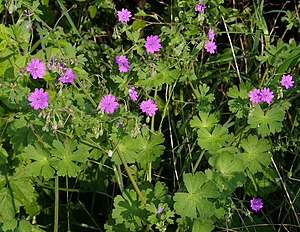Pyrenean cranesbill
| Pyrenean cranesbill | ||||||||||||
|---|---|---|---|---|---|---|---|---|---|---|---|---|

Pyrenean cranesbill ( Geranium pyrenaicum ) |
||||||||||||
| Systematics | ||||||||||||
|
||||||||||||
| Scientific name | ||||||||||||
| Geranium pyrenaicum | ||||||||||||
| Burm.f. |
The Pyrenees cranesbill ( Geranium pyrenaicum ) is a plant from the family of geraniaceae (Geraniaceae).
description
The Pyrenean cranesbill is a biennial, perennial or perennial herbaceous plant and reaches heights of 20 to 60 centimeters. It has a thick, fairly deep tap root and a very short, upright, scaly rhizome . The stem is protruding long and hairy, also short-glanded towards the top. The spreads of the evergreen leaves are round in outline, five to nine columns and cut to about the middle.
The partial inflorescences clearly tower above their bracts; their stalks are also densely short-glanded and hairy longer. The petals are almost twice as long as the sepals . The two-column petals are purple in color and 6 to 10 millimeters long. The flowering period extends from May to October.
The fruits have the typical cranesbill-like shape.
The species has chromosome number 2n = 26 or 28.
ecology
The Pyrenean cranesbill is a hemicryptophyte and a biennial to perennial semi-rosette plant. The rosette leaves have a supporting function as in Geranium robertianum.
The flowers are nectar-bearing, proterandric disc flowers; they are (mostly) pollinated by insects ; Diptera , Hymenoptera and some Coleoptera were observed as flower visitors ; Self-pollination should be possible. At night and in cloudy weather, the flowers are closed.
The flowering period extends from May to October.
The fruits are endozoochoric and autochoric: It is a centrifugal fruit (desiccation spreader): when the fruit ripens, the partial fruits detach from the central column, the awns bend upwards, the fruit compartment detaches and is thrown away together with the enclosed seeds , the throwing distance can be up to 2.1 m; the awns also detach from the central column.
The fruit ripens from July to October.
Occurrence
The Pyrenean cranesbill is native to the mountains of southern Europe , the Pyrenees, the southern Alps, the mountains of the Mediterranean and the Caucasus. He has been naturalized in Germany since around 1800 ( neophyte ). Probably this species was cultivated as an ornamental plant and it overgrown from gardens.
The Pyrenean cranesbill is quite common in sunny, gappy weed meadows, in vineyards, on walls and embankments. It prefers nutrient-rich soils in areas with a milder climate.
In the Allgäu Alps, it climbs up to 1730 m a.s.l. at the Jöchelspitze lift in Tyrol.
According to Ellenberg , it is a light plant, distributed sub-oceanic, a freshness pointer, a weak acid to weak base pointer, a pronounced nitrogen pointer and a class character of ruderal mugwort and thistle societies (Artemisietea vulgaris). In Central Europe it also occurs in societies of the Sisymbrion or Arrhenatherion associations.
Use in horticulture
From a horticultural point of view, the Pyrenean cranesbill is placed next to the woody perennials - this summarizes those perennials that thrive under light-shaded or alternating-shaded site conditions. They are therefore suitable for planting a perennial bed that offers these conditions. Today, in addition to purple-blooming varieties, white and deep purple varieties are also offered as ornamental plants.
literature
- Henning Haeupler, Thomas Muer: picture atlas of the fern and flowering plants of Germany . Ed .: Federal Agency for Nature Conservation (= The fern and flowering plants of Germany . Volume 2 ). Eugen Ulmer, Stuttgart (Hohenheim) 2000, ISBN 3-8001-3364-4 .
- Werner Rothmaler (greeting), Rudolf Schubert, Klaus Werner, Hermann Meusel (ed.): Excursion flora for the areas of the GDR and the FRG. Volume 2: Vascular Plants. 12th edition. People and Knowledge, Berlin 1983.
- Siegmund Seybold (Ed.): Schmeil-Fitschen. Interactive flora of Germany. Seeing - determining - knowing. The key to the flora . CD-ROM, version 2.0. Quelle & Meyer, Wiebelsheim 2004, ISBN 3-494-01368-3 .
- Erich Oberdorfer : Plant-sociological excursion flora for Germany and neighboring areas . With the collaboration of Angelika Schwabe and Theo Müller. 8th, heavily revised and expanded edition. Eugen Ulmer, Stuttgart (Hohenheim) 2001, ISBN 3-8001-3131-5 .
- Margot Spohn, Marianne Golte-Bechtle: What is blooming there? The encyclopedia: over 1000 flowering plants from Central Europe. Kosmos, Stuttgart 2005, ISBN 3-440-10326-9 .
- Ruprecht Düll , Herfried Kutzelnigg : Pocket dictionary of plants in Germany and neighboring countries. The most common Central European species in portrait. 7th, corrected and enlarged edition. Quelle & Meyer, Wiebelsheim 2011, ISBN 978-3-494-01424-1 .
further reading
- Dietmar Brandes: Geranium pyrenaicum Burm. f., a successful but inconspicuous neophyte? In: Braunschweiger natural history writings. Volume 7, 2004, pp. 49-71, online.
Individual evidence
- ↑ a b Erich Oberdorfer : Plant-sociological excursion flora for Germany and neighboring areas . 8th edition. Stuttgart, Verlag Eugen Ulmer, 2001. Page 626. ISBN 3-8001-3131-5
- ↑ Erhard Dörr, Wolfgang Lippert : Flora of the Allgäu and its surroundings. Volume 2, IHW, Eching 2004, ISBN 3-930167-61-1 , pp. 168-169.
Web links
- Pyrenean cranesbill. In: FloraWeb.de.
- Profile and distribution map for Bavaria . In: Botanical Information Hub of Bavaria .
- Geranium pyrenaicum Burm. f. In: Info Flora , the national data and information center for Swiss flora . Retrieved November 28, 2015.
- Distribution in the northern hemisphere according to Eric Hultén
- Thomas Meyer: Data sheet with identification key and photos at Flora-de: Flora von Deutschland (old name of the website: Flowers in Swabia )
- Characteristics





